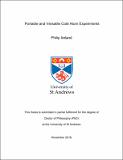Files in this item
Portable and versatile cold atom experiments
Item metadata
| dc.contributor.advisor | Cassettari, Donatella | |
| dc.contributor.author | Ireland, Philip | |
| dc.coverage.spatial | xi, 143 p. | en_US |
| dc.date.accessioned | 2019-06-26T13:53:58Z | |
| dc.date.available | 2019-06-26T13:53:58Z | |
| dc.date.issued | 2019-06-24 | |
| dc.identifier.uri | https://hdl.handle.net/10023/17969 | |
| dc.description.abstract | This thesis describes the progress achieved towards two goals. One is the construction of a compact magneto-optical trap (MOT) apparatus, used both as a standalone undergraduate laboratory experiment and as part of a public engagement demonstration of cold atom physics. The setup, which utilises a dichroic atomic vapour laser lock (DAVLL) system plus homemade sideband generation electronics, is capable of trapping and cooling up to 8x10⁷ ⁸⁵Rb atoms in a standard six-beam laser cooling scheme. The second goal is the loading of an ultracold ensemble of ⁸⁷Rb atoms into novel optical trap geometries using a phase-only liquid crystal spatial light modulator (LC SLM) for applications to atomtronics and quantum simulation. Details of a double vacuum chamber apparatus, designed to produce the first Bose-Einstein condensates (BECs) at St Andrews, are provided. The setup incorporates a hybrid trap evaporative cooling scheme towards quantum degeneracy and reliably produces BECs of 1.9 10⁵ ⁸⁷Rb atoms. Two computational techniques, developed during the course of this project, are presented with the aim of creating flexible, smooth holographic optical traps. The first method illuminates a single SLM with overlapped, co-propagating light beams of different wavelengths to create a composite optical pattern for atom manipulation. The second uses conjugate gradient minimisation to create exceptionally high fidelity light patterns in both amplitude and phase for light in the output plane. These techniques, combined with the implementation of a light sheet into the experimental setup, are used to trap atoms in both a ring profile and in a set of narrow waveguides connected with a tunnelling barrier. | en_US |
| dc.language.iso | en | en_US |
| dc.publisher | University of St Andrews | |
| dc.subject.lcc | QC175.47B65I8 | |
| dc.subject.lcsh | Low temperatures | en |
| dc.subject.lcsh | Atoms | en |
| dc.subject.lcsh | Bose-Einstein condensation | en |
| dc.subject.lcsh | Holography | en |
| dc.subject.lcsh | Light modulators | en |
| dc.title | Portable and versatile cold atom experiments | en_US |
| dc.type | Thesis | en_US |
| dc.contributor.sponsor | Engineering and Physical Sciences Research Council (EPSRC) | en_US |
| dc.contributor.sponsor | University of St Andrews. School of Physics and Astronomy | en_US |
| dc.type.qualificationlevel | Doctoral | en_US |
| dc.type.qualificationname | PhD Doctor of Philosophy | en_US |
| dc.publisher.institution | The University of St Andrews | en_US |
| dc.identifier.doi | https://doi.org/10.17630/10023-17969 |
This item appears in the following Collection(s)
Items in the St Andrews Research Repository are protected by copyright, with all rights reserved, unless otherwise indicated.

